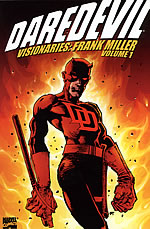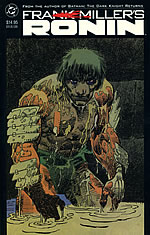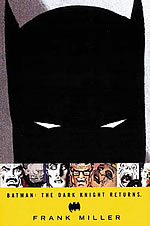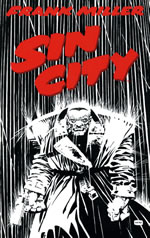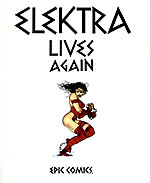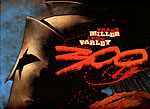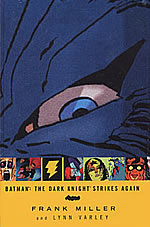Frank Miller:
It's Miller Time
Autumn in Vermont. Dense woodlands become a fiery kaleidoscope of reds, oranges, yellows. This was the tranquil setting in Smallville America where Frank Miller was raised a Catholic, comic book freak and dreamer. Into his teens he lost interest in superheroes and turned instead to crime, absorbing the genre’s masters and crafting his first amateur efforts.
To this 19 year-old country boy, moving to the real mean streets of New York in 1976 was a rude awakening. Muggings, robberies, murders, were not the stuff of fiction or Gotham City anymore, but on his doorstep, in his face. "I had to adapt to survive and that involved some changes inside myself, changes which contributed to the macho fantasy of the street vigilante."
He also had to adapt to survive in the struggling comics business. Nobody was publishing crime comics back then. The only game in town was superheroes, so Miller taught himself and in the spring of 1979 he landed the pencilling assignment on a languishing Marvel B-feature, Daredevil. Taking over the writing chores, Miller stripped Daredevil back to its essence of a lone blind man fighting for justice as a lawyer and costumed vigilante and re-tuned it into the crime comic he had always wanted to draw.
Not since Jim Steranko and Neal Adams had anyone applied such an armoury of storytelling techniques to superheroics. Miller had studied their work and that of the artists who had inspired them, Will Eisner and EC Comics pioneers Harvey Kurtzman, Bernie Krigstein, Johnny Craig. Miller exploded the whole page and double-page spread, breaking down the action into flow charts of multiple panels, horizontal and widescreen, vertical and kinetic.
It was not long before Miller realised the folly of insisting that his comics function purely as film. Still, his impact on Daredevil and Wolverine resulted in his being headhunted by rivals DC, who gave him virtually carte blanche in 1983 to create whatever he wanted. Martial arts and Japanese comics, especially Kazuo Koike and Goseki Kojima’s Lone Wolf & Cub, were exciting him and surfaced in Ronin, his underrated cross-genre samurai/science fiction saga. He also incorporated discoveries from French bande dessinée geniuses Moebius and Bilal. While on Ronin, Miller came to understand that everything in a comic must serve the narrative purpose, that each panel must move the story forward. Comics are not storyboards, animatics, flip-books or poor man’s film; they are their own language.
I remember talking with Miller back in the early Eighties when he was a guest at Italy’s prestigious comics festival, Lucca. He was in comics heaven. He had just met Hugo Pratt, godfather of Corto Maltese, and erotic maestro Guido Crepax and enthused to me about their work, the sophistication and production quality of European albums, the possibilities of bringing some of that to American comics.
Miller did just that and much more in Batman: The Dark Knight Returns. Today we’re blasé about fancy prestige formats, but in 1986 Miller’s four-issue series looked like nothing else before it in mainstream superhero comics: squarebound, card covers, forty-eight pages, fully painted colour, bleed printing, glossy paper, sharp design. The contents were equally revolutionary. After ten years, Batman, ageing, granite-faced, his costume and stomach sagging, comes out of retirement. Nothing, not even the law, will stop him taking his personal vendetta against criminals onto Gotham’s streets.
Miller’s dense, sixteen-panel grids instil claustrophobia and an adrenaline-pumping pulse, punctuated with larger images and full-page shots, nearly all on left-hand pages to maximise their surprise. In this intense, satirical and very dark bestseller, Miller provided the blueprint others would follow in comics, films and beyond. For him, writing Batman was dealing in legend, in folk tales, reviving the sweeping romanticism, the magic, that had been lost.
Still burning inside him was the desire to rejuvenate crime comics and in 1993 Dark Horse gave him the opportunity. His Sin City series comprises some of the hardest-boiled American graphic novels in the genre. Part Jim Thompson, part manga, visceral and violent, most are mercifully illustrated in black and white, sometimes accented with one thematic colour. Never subtle, almost funny in their studied machismo and sleaze, they are irresistibly manipulative.
Space sadly does not allow me to survey Miller’s writings for other artists, but praise should go to his truly gifted colourist and wife Lynn Varley. They were reunited on the baroque Daredevil tragedy Elektra Lives Again and then the unlikely historical epic 300. The latter was a richly painted, bombastic portrayal in landscape-format of the men who fought and died at Thermopylae. In many places the illustrations conjure up Frank Bellamy‘s bravura Heros the Spartan in Eagle.
Somewhere Miller described his much-anticipated return to Batman, in 2002’s Dark Knight Strikes Again, as a ‘dope slap’. He was bound to disappoint readers looking only for more of the same. Fifteen years have passed and Miller has different techniques and agendas for DK2. His imagery is harsher, more caricatured and irreverent. Varley’s moody watercolours are replaced by jarring, deliberately lower-res cybertextures. These suit his leaner, meaner and often laugh-out-loud satirical writing.
If anything, DK2 stokes DK1‘s satire of political corruption, flabby liberalism and media babble to wilder extremes. Looking like a beaten-up Popeye, Batman plots to restore hope and rescue his fellow superheroes from exile and abuse. This resurrection allows Miller’s taste for the romantic and operatic to mix with a subversive joy at the surrealism of DC lore. Miller has the nerve to play with all the toys, but Batman is the story’s beating heart, scheming in the shadows. As for its politics, Miller once declared, "Batman is an activist, a terrorist. I don’t write for ideologues. I’m a cartoonist and everybody’s fair game." Thankfully, PC is something Miller will never be.
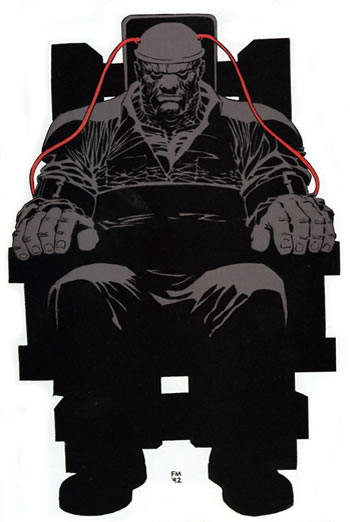
The original version of this article appeared in 2003 in the pages of Comics International, the UK’s leading magazine about comics.













